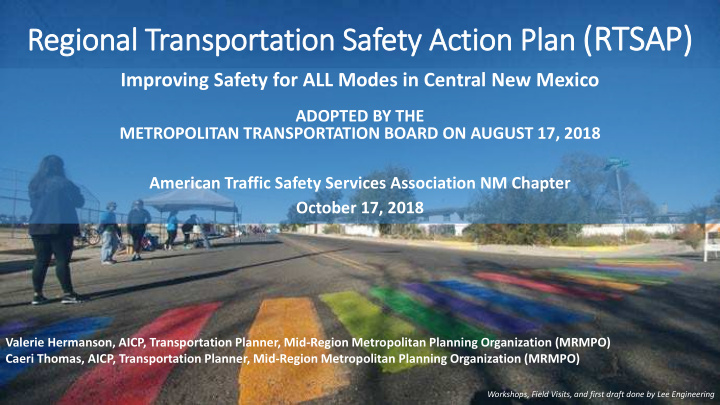



Plan (RTSAP) TSAP) Regional Transport rtation Safety Ac Action Pl Improving Safety for ALL Modes in Central New Mexico ADOPTED BY THE METROPOLITAN TRANSPORTATION BOARD ON AUGUST 17, 2018 American Traffic Safety Services Association NM Chapter October 17, 2018 Valerie Hermanson, AICP, Transportation Planner, Mid-Region Metropolitan Planning Organization (MRMPO) Caeri Thomas, AICP, Transportation Planner, Mid-Region Metropolitan Planning Organization (MRMPO) Workshops, Field Visits, and first draft done by Lee Engineering
Regional Crash Statistics Everyon one s e shou ould f feel saf afe a e and s secure g e get etting from om o one p e plac ace e 73 people die per year from a crash with 20 of those being to a anot other er – rega gard rdless t tra ravel m mode pedestrians—compare this to 61 homicides in 2016 in the City of • According to AAA, traffic Albuquerque. crashes cost society over three times more than 582 people per year have a serious congestion. or incapacitating injury with 40 of those being pedestrians. • This cost is on top of the estimated 2016 cost of maintaining and operating a car for one year (approximately $8,558). Totals for 2011 to 2015 geocoded crash data.
Snapshot – Metro Ar Area C Crash Trends ds 2% of crashes occurred in rural areas of the metro area, yet 14% of fatal crashes occurred in the rural areas. Excessive speed plays a prominent role in rural areas contributing to 20% of the deadly incidents . The majority of pedestrian and bicycle crashes are in the large urban area. Driving while intoxicated is the top contributing factor for fatalities in the urban area followed by excessive speed.
Regional T Travel b by Mode & & Fatalities • High pedestrian & motorcyclist fatalities in New Mexico Fatalities by • 30% of fatal crashes in our region Travel to Work by involve pedestrians Mode of Transportation Mode of Transportation • 53% of Fatal Crashes are Alcohol / Drug Involved as the Top Contributing Factor (TCF). • 59% of Fatal Pedestrian crashes are Alcohol/Drug Involved (unable to determine whether driver or pedestrian is at fault). • 54% of Fatal Motor Vehicle crashes are Alcohol/Drug Involved (one of the drivers is intoxicated). • New Mexico has higher speeding related fatalities than alcohol impaired fatalities (NHTSA, 2007- 2016 data). 2011 to 2015 Crash Data. Other includes Carpooled and Public Transportation
Top C Contributing F Fact ctors, Dangerous D Drivi ving, & th the La Law Source: City of Seattle 2011 to 2015 Regional Crash Data
High F h Fatal a and I d Injur ury N Net etwork ( (HFIN) • High Fatal and Injury Network (HFIN) developed to target funding & specific strategy types Efforts focused on most • dangerous streets & intersections to have the greatest impact on improving the safety of our streets for all modes • Analysis includes all fatal and injury crashes from 2011 to 2015 • NOT meant to be a comment on what has not been done, but rather help guide our future decision making to make greatest impact 64% of the total fatalities & • injuries occur on only 7% of the Major Roads network miles (and 2% of all roads in the AMPA)
Poten ential R Road Di Diet Ca Candidates A reallocation of roadway space that aims to reduce dangerous speeding and provide infrastructure for vulnerable road users. Road Diets are seen by some as the transportation safety field's greatest success story. Federal Highway Administration identified road diets as proven safety countermeasure with a 19-47% reduction in total crashes for a four lane conversation to three lanes (FHWA 2017). In 2014, the Federal Highway Administration released its Road Diet Informational Guide In 2016, New Mexico Department of Transportation released its road diet guide. 4 or 5 lanes with < = 20,000 ADT (2016) in blue High Fatal and Injury Network in red Example of how traffic lanes can be reconfigured as part of a road diet. Source: FHWA
Region onal T Transpor ortati tion S Safety ty Ac Action on Traffic Deaths are Vision VI Preventable. VISION ZERO Plan V People will make EMPHASIS AREAS 1) Reduce excessive speed and dangerous driving mistakes - the 2) Design streets for all modes of travel transportation system 3) Ensure strong policy and funding mechanisms 4) Implement meaningful behavior change campaigns should be designed so 5) Expand data collection and traffic management 6) Provide targeted traffic enforcement those mistakes are NOT INTERMEDIATE GOALS FOR NEXT FIVE (5) YEARS: fatal 1) A year over year reduction in fatal and injury crashes: A. At high priority corridors and intersections B. Related to excessive speed and dangerous driving C. Involving pedestrians and bicyclists D. Involving alcohol and drugs 2) An overall 5% to 10% reduction of the above categories of fatal and injury crashes over the next 5 years 3) A year over year increase in levels of comfort and safety experienced by bicyclists and pedestrians in traffic 4) Complete streets approach incorporated by all future construction projects from inception to completion
RTSAP AP R Recommenda endation: n: Adopt Vision Zero with Task Force • Vision Zero needs decision makers to champion this concept and who can help get it adopted and implemented • MRMPO recommends either NEW Vision Zero Task Force OR utilize existing committees to prioritize action items and achieve goals in this plan • MRMPO can lead and/or provide support to implementing actions • Potential Task Force members include, but are not limited to: planners, Source: National Transportation Safety Board extensive safety engineers, law enforcement, community health practitioners, local elected study 2017 officials, community members, and members of the disabled community Southwest corner of Central & San Mateo after ART Construction Southwest corner of Central & San Mateo before ART Construction
THANK NK Y YOU! OU! QUESTIONS?
Recommend
More recommend